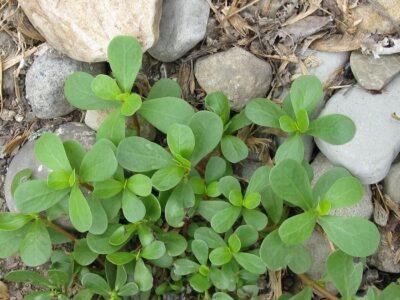
Image source: rustbeltvegetarian
To some a menacing weed, to others a wonderful tasty treat, it really depends on who you ask about purslane.
Purslane (portulaca oleracea) is native to India and Persia and has spread to almost all parts of the world as a plant and weed. Many cultures fully embrace purslane as a food while some just want it gone from their landscape.
However, those who came before us most certainly knew about purslane and its value. Early European settlers used this plant not only for nourishment but also to treat a wide range of ailments.
Nutritional value
There is very good reason, at least from a nutritional perspective, as to why purslane deserves more respect than it often gets. This herb contains alpha-linolenic acid, a much-researched and sought-after omega-3 fatty acid. In fact, purslane has about five times the amount of omega-3 fatty acid that spinach has and its stems are rich in vitamin C.
New Natural Fertilizer Doubles Garden Production!
A one-cup serving of this mighty herb provides all the vitamin E and magnesium you need in one day, along with 2,000 mg of calcium and 8,000 mg of potassium.
The calcium, potassium, magnesium, phenylalanine and tryptophan found in purslane are all substances which are known to have mood-boosting capabilities.
Interestingly enough, if you have backyard chickens, feeding them purslane will increase the omega-3 in their eggs by 20 percent.
Benefits of omega-3
There are a number of reasons to consider adding valuable omega-3 fatty acids to your diet. Omega-3 fatty acids are necessary for a number of bodily functions including protection against heart disease and stroke. Many new studies are also identifying potential benefits of omega-3 such as autoimmune diseases, cancer, cognitive decline and inflammatory bowel disease.
Vitamin C is a powerful antioxidant that keeps free radicals from sticking to the wall of arteries — thus it effectively prevents again heart disease and stroke. It is also important for the production of collagen. It is a natural pain fighter and inflammation reducer. In addition, vitamin C may also be an effective blood sugar regulator .
Identification
Purslane has thick, smooth and succulent leaves and stems that are decorated with lovely yellow flowers. They are quite similar in appearance to baby jade plants. From a single taproot, stems sprawl across the ground, forming a large mat of leaves.
Taste
Young and fresh plants are the preference of purslane connoisseurs. They taste similar to spinach or watercress with a bit of a peppery/lemony zip.
Where it grows
Purslane is hardy, and it will grow just about anywhere, including fertile garden soil to the nutrient poor and arid soils. It really enjoys a rocky area the best. Because it is a succulent, it is extremely drought tolerant. Sometimes, if you till a patch of soil, you will find that you have a hardy patch of purslane growing shortly afterward. This is because tilling bring the seeds to the surface where they will quickly germinate.
In the home garden
Scatter purslane seeds over an area but do not cover the seeds with soil as they need light to germinate. You can also plant purslane using cuttings; simply lay them on the ground where you wish to grow and water them. They will take root in a couple of days. Because purslane can become invasive, some people prefer to grow it in containers or raised beds.
Harvesting and using
Like all edibles, it is best to harvest purslane in the early morning or evening when the sun is not so hot. Collect the leaves and stem pieces using clean garden scissors and place them on a shallow tray, wash and pat dry before use. Use the pieces in raw salads, sauté in organic butter or coconut oil, steam them or put some in your green smoothie.
So, when you plan your edible landscape, consider purslane and all of it wonderful merits.
Do you eat purslane and have any tips? Tell us in the comments section below.
Sign up for Off The Grid News’ weekly email and stay informed about the issues important to you
 Off The Grid News Better Ideas For Off The Grid Living
Off The Grid News Better Ideas For Off The Grid Living




